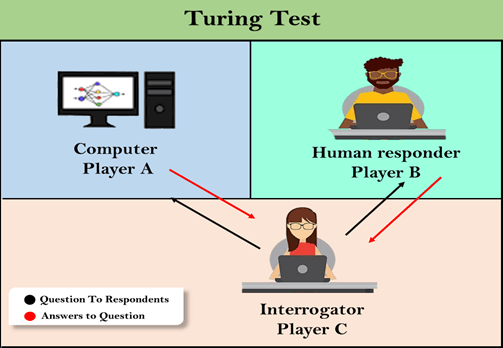In 1950, Alan Turing introduced a test to check whether a machine can think like a human or not, this test is known as the Turing Test. In this test, Turing proposed that the computer can be said to be an intelligent if it can mimic human response under specific conditions.
Turing Test was introduced by Turing in his 1950 paper, "Computing Machinery and Intelligence," which considered the question, "Can Machine think?"

The Turing test is based on a party game "Imitation game," with some modifications. This game involves three players in which one player is Computer, another player is human responder, and the third player is a human Interrogator, who is isolated from other two players and his job is to find that which player is machine among two of them.
Consider, Player A is a computer, Player B is human, and Player C is an interrogator. Interrogator is aware that one of them is machine, but he needs to identify this on the basis of questions and their responses.
The conversation between all players is via keyboard and screen so the result would not depend on the machine's ability to convert words as speech.
The test result does not depend on each correct answer, but only how closely its responses like a human answer. The computer is permitted to do everything possible to force a wrong identification by the interrogator.
The questions and answers can be like:
Interrogator: Are you a computer?
PlayerA (Computer): No
Interrogator: Multiply two large numbers such as (256896489*456725896)
Player A: Long pause and give the wrong answer.
In this game, if an interrogator would not be able to identify which is a machine and which is human, then the computer passes the test successfully, and the machine is said to be intelligent and can think like a human.
"In 1991, the New York businessman Hugh Loebner announces the prize competition, offering a $100,000 prize for the first computer to pass the Turing test. However, no AI program to till date, come close to passing an undiluted Turing test".
Chatbots to attempt the Turing test:
ELIZA: ELIZA was a Natural language processing computer program created by Joseph Weizenbaum. It was created to demonstrate the ability of communication between machine and humans. It was one of the first chatterbots, which has attempted the Turing Test.
Parry: Parry was a chatterbot created by Kenneth Colby in 1972. Parry was designed to simulate a person with Paranoid schizophrenia(most common chronic mental disorder). Parry was described as "ELIZA with attitude." Parry was tested using a variation of the Turing Test in the early 1970s.
Eugene Goostman: Eugene Goostman was a chatbot developed in Saint Petersburg in 2001. This bot has competed in the various number of Turing Test. In June 2012, at an event, Goostman won the competition promoted as largest-ever Turing test content, in which it has convinced 29% of judges that it was a human.Goostman resembled as a 13-year old virtual boy.
The Chinese Room Argument:
There were many philosophers who really disagreed with the complete concept of Artificial Intelligence. The most famous argument in this list was "Chinese Room."
In the year 1980, John Searle presented "Chinese Room" thought experiment, in his paper "Mind, Brains, and Program," which was against the validity of Turing's Test. According to his argument, "Programming a computer may make it to understand a language, but it will not produce a real understanding of language or consciousness in a computer."
He argued that Machine such as ELIZA and Parry could easily pass the Turing test by manipulating keywords and symbol, but they had no real understanding of language. So it cannot be described as "thinking" capability of a machine such as a human.
Features required for a machine to pass the Turing test:
- Natural language processing: NLP is required to communicate with Interrogator in general human language like English.
- Knowledge representation: To store and retrieve information during the test.
- Automated reasoning: To use the previously stored information for answering the questions.
- Machine learning: To adapt new changes and can detect generalized patterns.
- Vision (For total Turing test): To recognize the interrogator actions and other objects during a test.
- Motor Control (For total Turing test): To act upon objects if requested.
Comments
Post a Comment